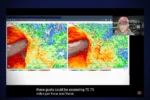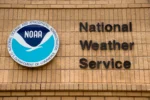Have you ever noticed how sometimes the weather can be really strange? One day it’s sunny, and the next it’s pouring rain! Scientists, known as climatologists, are warning us that in the future, weather might become even crazier. They believe we will face more extreme weather events like heavy storms, floods, and droughts. This means we need to pay attention! In this article, we’ll explore how climate change is making our weather more unpredictable and what we can do to help protect our planet from these wild weather swings.
| Category | Details |
|---|---|
| Warning Issued By | Climatologists and climate scientists |
| Date of Warning | February 15, 2025 |
| Key Issue | Increasing severity of weather patterns due to climate change |
| Examples of Extreme Weather | Droughts, floods, fires, tornadoes, hurricanes, heat waves, snowstorms, heavy rainfall, prolonged droughts |
| Consequences of Extreme Weather | Threat to lives and livelihoods; increased costs for businesses and insurance issues |
| Future Predictions | More extreme weather events will occur more frequently and with greater severity |
| Technological Solutions | Developing AI for predicting floods and capturing carbon emissions |
| Recommended Actions | Reduce pollution to mitigate extreme weather and improve air quality |
Understanding Extreme Weather Events
Extreme weather events are unusual and severe weather conditions that can happen anywhere in the world. These include heavy rain, droughts, hurricanes, and snowstorms. Scientists have noticed that these events are becoming more frequent and intense due to climate change. For example, a freezing polar vortex can cause extremely cold temperatures in places that usually have mild winters. Understanding these changes helps us prepare for their impacts and protect ourselves and our communities.
Climatologists warn that because of rising temperatures, we will see more extreme weather in the future. Barry Keim, a climate scientist, explains that we can expect heavy rainfall followed by long dry periods. This might sound strange, but it happens when storms become stronger and dump a lot of rain in a short amount of time. By learning about these patterns, we can better understand how to manage our resources and keep safe during harsh weather conditions.
The Impact of Extreme Weather on Communities
Extreme weather events can have a big impact on people’s lives and the economy. When severe storms hit, they can destroy homes, disrupt businesses, and make it hard for people to get to work. This can lead to financial problems for families and communities. Additionally, rising interest rates can make it more expensive for businesses to borrow money, which can slow down local economies. Understanding these effects helps us see why it’s important to take action against climate change.
Moreover, the availability of insurance is also affected by extreme weather. When disasters happen more often, insurance companies may raise their rates or even stop offering coverage in some areas. This can leave families unprotected when they need help the most. By recognizing the significance of these events, we can push for better solutions and support our communities in preparing for future challenges.
Taking Action Against Climate Change
To combat extreme weather, scientists are working on new technologies to predict and lessen the impacts of these events. For example, using generative AI can help forecast flooding from hurricanes more accurately. These advancements are important because they allow communities to prepare and respond better during emergencies. By learning about these technologies, we can stay informed and support efforts that protect our environment and safety.
However, the most effective way to reduce extreme weather is to decrease pollution that warms our planet. This means using cleaner energy sources instead of burning fossil fuels. By doing this, we not only help prevent extreme weather but also improve air quality, making our planet healthier for everyone. Simple actions like using less energy and recycling can make a big difference. Together, we can work towards a safer, cleaner future.
Understanding the Mechanisms Behind Extreme Weather Events
The connection between climate change and extreme weather events is rooted in the physics of our atmosphere. As global temperatures rise, the capacity of the atmosphere to hold moisture increases, leading to heavier rainfall during storms. This phenomenon can be attributed to the warmer air absorbing more water vapor, which eventually releases in intense downpours. Consequently, the frequency of flooding events is expected to rise, causing significant damage to infrastructure and ecosystems.
Conversely, higher temperatures also exacerbate drought conditions. As precipitation becomes less predictable, certain regions may experience prolonged dry spells, leading to water shortages and agricultural stress. This duality—more rain in some areas while others suffer from drought—illustrates the complexity of climate dynamics and underscores the importance of understanding these mechanisms to prepare for and mitigate future extreme weather impacts.
The Socioeconomic Impact of Climate Change on Communities
Extreme weather events disproportionately affect vulnerable communities, exacerbating existing inequalities. Low-income areas often lack the infrastructure to withstand severe storms or flooding, leading to higher rates of displacement and economic hardship. Furthermore, as insurance costs rise due to increased risks, many families find themselves unable to afford coverage, leaving them financially exposed during disasters. This cycle of vulnerability highlights the urgent need for equitable climate adaptation strategies.
In addition to housing, the economic ramifications of climate change extend to job security and public health. Industries reliant on stable weather patterns, such as agriculture and tourism, face unprecedented challenges, threatening livelihoods and local economies. Additionally, the stress of extreme weather can lead to mental health crises, as communities grapple with loss and uncertainty. Addressing these socioeconomic impacts requires a holistic approach that combines climate resilience with social support systems.
Innovative Solutions to Mitigate Extreme Weather Effects
Amid the growing concerns about extreme weather, innovative technologies are emerging to bolster resilience and adapt to changing conditions. One promising development is the use of AI-driven predictive models that provide real-time data on weather patterns, enabling communities to prepare for impending storms. By leveraging such technology, emergency services can allocate resources more effectively, ultimately saving lives and reducing damage during catastrophic events.
Moreover, advancements in sustainable practices are being explored to reduce carbon footprints and enhance environmental resilience. For instance, green infrastructure—like urban gardens and permeable pavements—can mitigate flood risks by absorbing excess rainwater. Transitioning to renewable energy sources not only contributes to cleaner air but also diminishes the reliance on fossil fuels that exacerbate climate change. These innovative solutions are crucial for fostering a sustainable future in the face of increasing weather extremes.
The Role of Policy in Combating Climate Change
Policy plays a pivotal role in addressing the challenges posed by extreme weather events. Governments worldwide are beginning to recognize the necessity of enacting stringent environmental regulations to curtail greenhouse gas emissions. Legislative measures that promote renewable energy adoption, enhance public transportation, and incentivize sustainable practices can significantly mitigate the effects of climate change. By prioritizing these initiatives, policymakers can pave the way for a more resilient society.
Furthermore, international cooperation is essential in the fight against climate change. Global agreements, such as the Paris Accord, aim to unite countries in their efforts to reduce emissions and share innovative solutions. Collaborative endeavors can lead to the development of comprehensive adaptation strategies, enabling nations to collectively navigate the complexities of climate impacts. Ultimately, proactive policies are vital for safeguarding not just the environment, but also the health and well-being of future generations.
Frequently Asked Questions
What are extreme weather events and why should we care about them?
**Extreme weather events** are unusual and severe weather conditions like **hurricanes, floods, and droughts**. We should care because they can harm people, animals, and the environment, making life difficult for many.
How does climate change affect weather patterns?
**Climate change** makes weather patterns more unpredictable. It causes **higher temperatures**, leading to more intense storms and longer periods of dry weather, which can be confusing but are linked together.
What can we do to help reduce extreme weather?
To help reduce extreme weather, we can **use less energy**, recycle, and choose cleaner options like **solar power**. Each small action contributes to a healthier planet.
Why are scientists worried about the future of weather?
Scientists are worried because they believe that **weather will become more extreme** and unpredictable. This means more severe storms, floods, and other dangerous conditions will likely happen more often.
What is being done to predict and manage extreme weather events?
Scientists are creating new technologies, like using **AI** to predict floods. These tools help us understand and prepare for extreme weather, making it safer for everyone.
How do extreme weather events impact our daily lives?
Extreme weather can affect our daily lives by causing **damage to homes**, impacting **food supplies**, and even raising **insurance costs**. This makes it harder for families and businesses to recover.
What are some examples of extreme weather events we might see more often?
Examples include **hurricanes**, **heavy rain**, **snowstorms**, and **heat waves**. These events used to be rare, but they are expected to happen more frequently due to climate change.
Summary
Climatologists warn that the world will face increasingly severe weather patterns due to climate change. Extreme events, such as heavy rainfall and prolonged droughts, are expected to become more frequent and intense, as highlighted by a Louisiana State University climate scientist. The correlation between rising temperatures and severe weather is crucial, as unchecked climate change will exacerbate these conditions, impacting lives and economies. Innovative technologies are being developed to predict and mitigate these events, but reducing pollution remains the most effective method to protect against future extremes while improving air quality.







